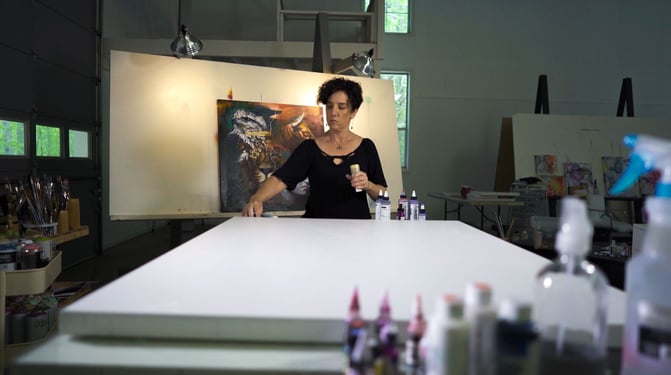The Italian/Portuguese word Gesso is literally translated into English as plaster (or soft, white rock). When this chalk dust is mixed with white pigment and a binder, it was used as a primer substitute for paintings. Historically, the binder was usually rabbit-skin glue.
The modern version of gesso was developed by Henry Levison in 1955. It consisted of calcium carbonate, pigment, and acrylic polymer. He called it Liquitex, “a perfect blend of liquid and texture.” It’s thinner than white acrylic paint and dries hard.
Create With Confidence
🌍 You don’t have to create alone. In the Mastery Program, you’ll learn proven techniques, connect with inspiring artists, and finally share your work with the world. 🎉 Begin your journey today! ✨

Gesso, like paints, comes in two grades—student and professional. As with paints, student-grade gesso has less pigment and more filler. While being less expensive, it is not necessarily more economical. You will generally use less of the professional grade because you have better coverage.
Gesso generally is white, black, or clear. However, you can now also find it in varying background colors.
Gesso: Its Purpose
The main purpose of gesso is to coat surfaces in preparation for painting. One of the most common surfaces is canvas. Without gesso, your paint would soak right into the canvas. Gesso provides a smooth yet slightly textured surface, or tooth, that helps your paint stick to your canvas without soaking in.
Gesso: Its Application
After you’ve stretched your canvas, it’s important to add several coats of gesso to prepare it for painting. First, you need to make sure that all dust and other particles are removed from your canvas.
Brush on a thin, even layer and let it dry completely. If you’d like a smoother surface, lightly sand your canvas in between coats of gesso. Keep in mind that it’s very important to let the gesso dry completely before sanding it.
Currently, pre-gessoed canvases are easily available at multiple art supply stores. Again, if you want a very smooth surface, lightly sand the canvas, remove all dust, and brush another thin, even layer of gesso on it. Depending on the smoothness you desire will determine how many times you’ll sand and then reapply more gesso.
Final Thoughts On Gesso
Gesso is really a bridge between the surface you’re using and the paint you want to use. You can gesso almost anything to prepare it for the beautiful painting you’ll create. And remember, the more layers you brush on, the smoother your surface will be.
Create With Confidence
🌍 You don’t have to create alone. In the Mastery Program, you’ll learn proven techniques, connect with inspiring artists, and finally share your work with the world. 🎉 Begin your journey today! ✨
